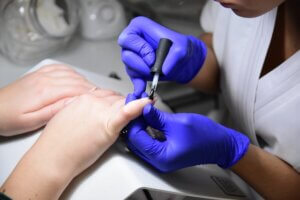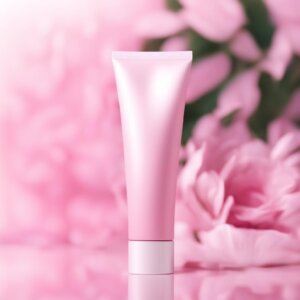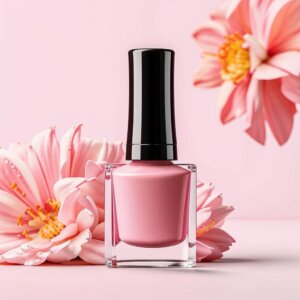This guide will show you how to fix polygel that is too thick.
Whether polygel you’re using has a texture that’s too thick or your polygel is too bulky under the nail, or polygel extensions you’ve created have turned out to be way too chunky, or the polygel layer on your form is overly heavy — this guide has all the answers.

Polygel nail is too thick: how to file it down?
If the polygel nails you’ve done have turned out to be too chunky and you don’t like the way they look you can fix them by filing the material down.
Nail drill
The quickest and easiest way to do it is by using a nail drill.
Use a barrel-shaped nail drill bit or any bit that you personally prefer.
When filing, apply the bottom half of the side of the bit to the polygel nail’s surface and always file in one direction only.
Filing back and forth will be harder to control and may result in removing too much material.
Only file the tip of the polygel nail down to make the edge look thinner.
This alone will prevent your polygel nails from looking too thick.
However, never file the apex of your polygel nails down. This will compromise the strength of the nail and may lead to breakage.
Also, don’t make the edge of the nail and its sides thinner than 0.5 mm.
Nail file
If you don’t have a nail drill don’t fret.
You can easily file this material down with a nail file. However, it will take more time and effort.
Get a 150 or 180 grit emery board nail file.
These grit numbers are the best levels of coarseness for working with polygel.
Emery board has the necessary strength and flexibility for filing artificial nails. Plus, when it gets worn down, it’s easy to replace.
The shape of the nail file that I recommend using is the half-moon shape because it’s the most ergonomic one for holding in your hands. But you can choose any shape you personally like.
Again, only file the area close to the edge and avoid filing down the apex of the nail.
Then buff the nail to smoothness using a 100/180 grit nail buffer.
Polygel’s texture is too thick
Some polygels have a very thick and overly viscous texture.
This makes the material stubborn and difficult to shape and move around.
How to soften polygel?
The first thing you should do is simply use more slip solution when shaping your polygel nails.
And I don’t mean soaking the brush in it too much.
Just dip the brush in this liquid more often than you normally would.
In addition to that, polygel thickens at cold temperatures and becomes more pliable in a warm room.
So if your polygel’s texture is too firm you can try working in a warmer environment.
If all else fails, put the tube of polygel in an airtight bag, seal it, and place it under warm water for a few minutes.
Just make sure the water isn’t too hot and that no liquid gets into the bag.
What you should never use to soften polygel
Never try to thin out polygel in the same way as you thin out nail polish.
Adding polish thinners or acetone won’t work. This will only break the structure of polygel and ruin it.
Don’t try pouring slip solution or rubbing alcohol into a tube of polygel or mixing slip solution/alcohol with polygel in a dish.
This will also ruin this material.
You should only dip your brush into the slip solution a bit and then pat the brush against the polygel on the form or smooth out the polygel with the brush.
Polygel layer on the form is too thick
If you apply polygel in an overly thick layer you’re going to have problems.
- Your polygel layer won’t cure properly because UV rays won’t be able to penetrate suck a thick pile of material.
The nail will remain soft at the apex and can break easily.
- When you press the form against your nail plate excess polygel will be pushed out over the edges of the form and will make a mess.
You’ll either be forced to re-do the whole nail or you’ll need to remove excess material that got squeezed out of the form before you place your hand under the lamp.
Because if you cure it as is you’ll have a huge problem with a super-strong acetone-resistant material stuck to your skin.
You won’t be able to soak it off and filing it off can be damaging to the skin.
What should you do to prevent making your polygel layer too thick?
Try to squeeze a smaller bead of polygel out of the tube onto your picker tool.
The bead should be large enough to spread over the length of your form but not too large.
The material layer should be thicker in the middle where the nail’s apex is but thinner near the edge and on the sides.
However, don’t spread it too thin either. Again, the edge and the sides of your polygel nails should be no thinner than 0.5 mm.
Polygel is too thick under the nail
If your polygel is too thick under the nail that means the layer of polygel you’ve applied to your dual form was too thick, especially at the edge.
Next time, spread less material in that area.
But if you’ve already placed the form with a lot of polygel on the nail plate and it has gathered under your natural nail’s edge try to smooth it out and spread it thinner with your brush. Or remove extra material with the brush before you cure it.
If you’ve already cured your polygel overlay and it’s too thick under your natural nail you can remove excess material with a nail drill.
Use a special under nail cleaner bit and gently file the underside of your nail.
But make sure the edge stays thicker than 0.5 mm.
Recommended reading:
Best Polygel Nail Kit Reviews And How To Apply Polygel At Home
Best Glitter Polygel Nail Kits
Best And Safest Neon Polygel Nail Kits
Best Polygel Dual Forms For Perfect Nail Extensions
Is Polygel Bad For Your Nails? 9 Reasons Why It’s Safe
What Is Polygel Made Of? Polygel Ingredients Explained
How To Dry Polygel Without A UV Light
Can I Use Water As A Slip Solution For Polygel?
Best Professional Gel Nail Polish Brands Used In Salons
Non-Toxic Gel Nail Polish Brands 101: Choose The Safest Gel Nail Polish
Best No Light Gel Polish — Gel Nail Polish Without UV Light
Best Small Salon Reception Desk For A Tight Space: Make An Amazing First Impression!










